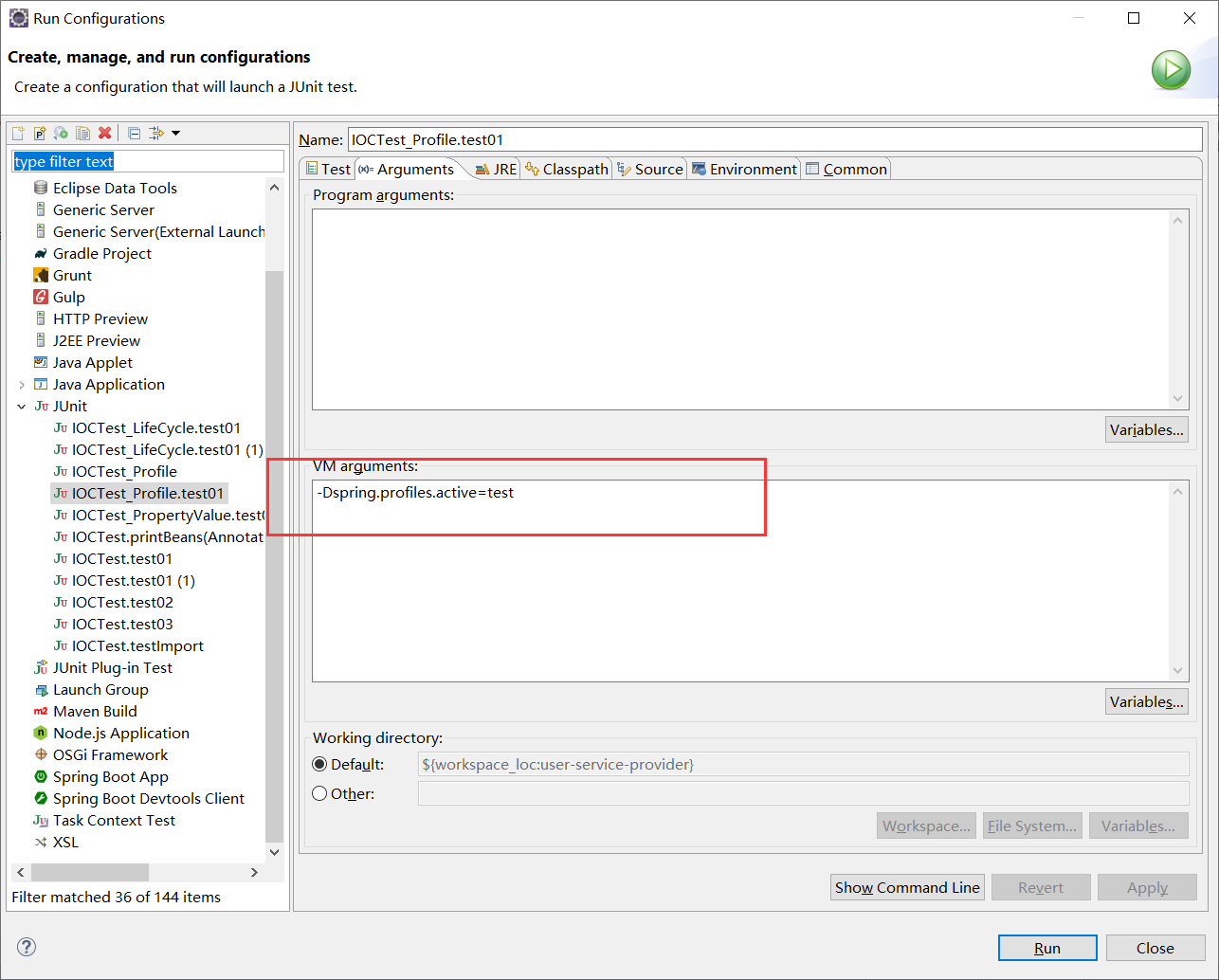十、Spring的@Profile注解
首先我们来看看spring官方文档对这个注解的解释:
The
@Profileannotation allows you to indicate that a component is eligible for registration when one or more specified profiles are active
这个注解可以根据当前的环境,动态的激活和切换一系列组件的功能
结合之前的一些知识,做一个例子,在我们开发的时候,可能在开发的时候连接的是开发环境的数据库,在测试的时候连接测试环境,生产环境连接的是生产数据库,不同环境下使用的数据库是不同的,如何动态的切换数据源的注入呢?
配置类讲解
首先看一下配置类MainConfigProfile类
import javax.sql.DataSource;
import org.springframework.beans.factory.annotation.Value;
import org.springframework.context.EmbeddedValueResolverAware;
import org.springframework.context.annotation.Bean;
import org.springframework.context.annotation.Configuration;
import org.springframework.context.annotation.Profile;
import org.springframework.context.annotation.PropertySource;
import org.springframework.util.StringValueResolver;
import com.atguigu.bean.Yellow;
import com.mchange.v2.c3p0.ComboPooledDataSource;
/**
* Profile:
* Spring为我们提供的可以根据当前环境,动态的激活和切换一系列组件的功能;
*
* 开发环境、测试环境、生产环境;
* 数据源:(/A)(/B)(/C);
*
*
* @Profile:指定组件在哪个环境的情况下才能被注册到容器中,不指定,任何环境下都能注册这个组件
*
* 1)、加了环境标识的bean,只有这个环境被激活的时候才能注册到容器中。默认是default环境
* 2)、写在配置类上,只有是指定的环境的时候,整个配置类里面的所有配置才能开始生效
* 3)、没有标注环境标识的bean在,任何环境下都是加载的;
*/
@PropertySource("classpath:/dbconfig.properties")
@Configuration
public class MainConfigOfProfile implements EmbeddedValueResolverAware{
@Value("${db.user}")
private String user;
private StringValueResolver valueResolver;
private String driverClass;
@Bean
public Yellow yellow(){
return new Yellow();
}
@Profile("test")
@Bean("testDataSource")
public DataSource dataSourceTest(@Value("${db.password}")String pwd) throws Exception{
ComboPooledDataSource dataSource = new ComboPooledDataSource();
dataSource.setUser(user);
dataSource.setPassword(pwd);
dataSource.setJdbcUrl("jdbc:mysql://localhost:3306/test"); // 测试库
dataSource.setDriverClass(driverClass);
return dataSource;
}
@Profile("dev")
@Bean("devDataSource")
public DataSource dataSourceDev(@Value("${db.password}")String pwd) throws Exception{
ComboPooledDataSource dataSource = new ComboPooledDataSource();
dataSource.setUser(user);
dataSource.setPassword(pwd);
dataSource.setJdbcUrl("jdbc:mysql://localhost:3306/ssm_crud"); // 开发库
dataSource.setDriverClass(driverClass);
return dataSource;
}
@Profile("prod")
@Bean("prodDataSource")
public DataSource dataSourceProd(@Value("${db.password}")String pwd) throws Exception{
ComboPooledDataSource dataSource = new ComboPooledDataSource();
dataSource.setUser(user);
dataSource.setPassword(pwd);
dataSource.setJdbcUrl("jdbc:mysql://localhost:3306/scw_0515"); // 生产库
dataSource.setDriverClass(driverClass);
return dataSource;
}
@Override
public void setEmbeddedValueResolver(StringValueResolver resolver) {
// TODO Auto-generated method stub
this.valueResolver = resolver;
driverClass = valueResolver.resolveStringValue("${db.driverClass}");
}
}
在配置类中我们注入了三个Bean,分别对应测试环境、开发环境、生产环境。
我们知道数据源的注入需要四大金刚:user、password、driver、url。
注意:这里,三种环境连接的都不是相同的数据库,我们这里只以url作为区分。每个环境下的url是不同的。
其他三个参数,我们都配置在类路径下的db.properties中,如下
db.user=root
db.password=123456
db.driverClass=com.mysql.jdbc.Driver
这里结合之前我学习的知识点,使用不同的方式注入db.properties中的值
使用是加载资源文件,这个用法可参阅:Spring中使用@Value和@PropertySource为属性赋值
@PropertySource("classpath:/dbconfig.properties")
那如何为
dataSource.setUser(user);
dataSource.setPassword(pwd);
这两句中的方法赋值呢?
第一个我们构造了一个
private String user;属性,然后在属性上通过@Value("${db.user}")然后再
dataSource.setUser(user);就拿到值了。
其次呢,
public DataSource dataSourceDev(@Value("${db.password}")String pwd) throws Exception{...}我们在方法上添加了一个参数,在参数前加上了@Value("${db.password}")便可以从资源文件db.properties中拿到值,赋给这个参数
小结:以上是@Value的用法,可参考上面的链接
进行到这里,我们换一种方式,来取得资源文件中的driverClass,
我们可以通过实现EmbeddedValueResolverAware接口,spring中有很多aware接口,是提供给我们使用spring底层功能的途径。
这里的EmbeddedValueResolverAware就是值解析器 ,实现该接口,即实现其抽象方法
@Override
public void setEmbeddedValueResolver(StringValueResolver resolver) {
// TODO Auto-generated method stub
this.valueResolver = resolver;
driverClass = valueResolver.resolveStringValue("${db.driverClass}");
}
在容器启动的时候 ,这个方法会被调用,
我们定义 了一个属性,用以接收方法中参数的值,也即StringValueResolver resolver
private StringValueResolver valueResolver;
然后解析
driverClass = valueResolver.resolveStringValue("${db.driverClass}");
并赋值给我们自定义的属性driverClass。这样这个属性就拿到了资源文件中的值
以上和@Profile没有太大的关系,但可以很好的复习
另外我们还在配置类中,定义 了一个叫做yellow的bean。
测试,并激活对应的环境
首先我们全部不加入@Profile注解
测试一下,观察控制台输出,该方法我们就称为测试方法1
package com.atguigu.test;
import javax.sql.DataSource;
import org.junit.Test;
import org.springframework.context.annotation.AnnotationConfigApplicationContext;
import com.atguigu.bean.Yellow;
import com.atguigu.config.MainConfigOfProfile;
public class IOCTest_Profile {
@Test
public void test01(){
AnnotationConfigApplicationContext applicationContext = new AnnotationConfigApplicationContext(MainConfigOfProfile.class);
String[] definitionNames = applicationContext.getBeanDefinitionNames();
for (String name : definitionNames) {
System.out.println(name);
}
}
}
mainConfigOfProfile
yellow
testDataSource
devDataSource
prodDataSource
可以看到包含配置类本身所有的bean都被注入到了ioc容器中。
现在打开所有的@Profile注释
比如现在我们是在dev即开发环境下,如何只激活@Bean("devDataSource")这个组件呢?
我们写个测试类
package com.atguigu.test;
import javax.sql.DataSource;
import org.junit.Test;
import org.springframework.context.annotation.AnnotationConfigApplicationContext;
import com.atguigu.bean.Yellow;
import com.atguigu.config.MainConfigOfProfile;
public class IOCTest_Profile {
//1、使用命令行动态参数: 在虚拟机参数位置加载 -Dspring.profiles.active=test
@SuppressWarnings("resource")
//2、代码的方式激活某种环境;
@Test
public void test01(){
AnnotationConfigApplicationContext applicationContext =
new AnnotationConfigApplicationContext();
//1、创建一个applicationContext
//2、设置需要激活的环境
applicationContext.getEnvironment().setActiveProfiles("dev"); // 这里可以写多个值,
//3、注册主配置类
applicationContext.register(MainConfigOfProfile.class);
//4、启动刷新容器
applicationContext.refresh();
String[] namesForType = applicationContext.getBeanNamesForType(DataSource.class);
for (String string : namesForType) {
System.out.println(string);
}
Yellow bean = applicationContext.getBean(Yellow.class);
System.out.println(bean);
applicationContext.close();
// AnnotationConfigApplicationContext applicationContext = new AnnotationConfigApplicationContext(MainConfigOfProfile.class);
// String[] definitionNames = applicationContext.getBeanDefinitionNames();
// for (String name : definitionNames) {
// System.out.println(name);
// }
}
}
控制台打印:
devDataSource
com.atguigu.bean.Yellow@27ce24aa // 没有被@Profile修饰。
观察可以发现,确实只有开发环境的bean被注入了ioc容器中,
这里还有另外一种激活@Profile注解 的方式。
测试方法1:
@Test
public void test01(){
AnnotationConfigApplicationContext applicationContext = new AnnotationConfigApplicationContext(MainConfigOfProfile.class);
String[] definitionNames = applicationContext.getBeanDefinitionNames();
for (String name : definitionNames) {
System.out.println(name);
}
}
然后运行该方法,不过需要在运行时候加上虚拟机参数。=后面是我们需要激活的环境,多个值用逗号分隔开。
-Dspring.profiles.active=test

打印一下输出:
mainConfigOfProfile
yellow
testDataSource //测试环境被注入
@Profile注解 使用在类上,
保持配置类不变,我们在该配置类上加上@Profile("prod")
我们在来运行测试方法1(前面有提),控制台并没有输出,这表示配置类中的bean都没有被注入进容器中,
可以这样思考:@Profile注解标注在类上,如果你没有指定激活该环境,自然该配置类整个都不会被加载,配置类中的Bean(即使如Yellow,没有被@Profile注解),也不会被注入进容器中,
那我们以同样的方式,来正确的激活该环境后呢?(如何激活环境,参考前文)
控制台打印输出
mainConfigOfProfile
yellow
prodDataSource
这显然与我们预料的是一致的。
Tips
如果环境都没有被激活,那@Profile("default")会被激活,也就是说,默认就是default环境。
十、Spring的@Profile注解的更多相关文章
- 【译】Spring 4 @Profile注解示例
前言 译文链接:http://websystique.com/spring/spring-profile-example/ 本文将探索Spring中的@Profile注解,可以实现不同环境(开发.测试 ...
- 【转】Spring Boot Profile使用
http://blog.csdn.net/he90227/article/details/52981747 摘要: spring Boot使用@Profile注解可以实现不同环境下配置参数的切换,任何 ...
- 使用 spring.profiles.active 及 @profile 注解 动态化配置内部及外部配置
引言:使用 spring.profiles.active 参数,搭配@Profile注解,可以实现不同环境下(开发.测试.生产)配置参数的切换 一.根据springboot的配置文件命名约定,结合ac ...
- spring boot: 一般注入说明(四) Profile配置,Environment环境配置 @Profile注解
1.通过设定Environment的ActiveProfile来设置当前context所需要的环境配置,在开发中使用@Profile注解类或方法,达到不同情况下选择实例化不同的Bean. 2.使用jv ...
- 【Spring Cloud】Spring Cloud之自定义@SpringCloudProfile注解实现@Profile注解的功能
一.为什么会想到定义@SpringCloudProfile这样的注解 首页提一下@Profile注解:它主要用与Spring Boot多环境配置中,指定某个类只在指定环境中生效,比如swagger的配 ...
- spring切换环境变量——@Profile注解的使用
在容器中如果存在同一类型的多个组件,也可以使用@Profile注解标识要获取的是哪一个bean,这在不同的环境使用不同的变量的情景特别有用.例如,开发环境.测试环境.生产环境使用不同的数据源,在不改变 ...
- 【Spring】使用@Profile注解实现开发、测试和生产环境的配置和切换,看完这篇我彻底会了!!
写在前面 在实际的企业开发环境中,往往都会将环境分为:开发环境.测试环境和生产环境,而每个环境基本上都是互相隔离的,也就是说,开发环境.测试环境和生产环境是互不相通的.在以前的开发过程中,如果开发人员 ...
- Spring核心技术(十)——JSR-330标准注解
从Spring 3.0开始,Spring开始支持JSR-330标准的注解(依赖注入).这些注解和Spring注解扫描的方式是一直的,开发者只需要在classpath中配置相关的jar包即可. 如果开发 ...
- 朱晔和你聊Spring系列S1E9:聊聊Spring的那些注解
本文我们来梳理一下Spring的那些注解,如下图所示,大概从几方面列出了Spring的一些注解: 如果此图看不清楚也没事,请运行下面的代码输出所有的结果. Spring目前的趋势是使用注解结合Java ...
随机推荐
- 聊聊rocketmq的ConsumeMode.CONCURRENTLY
序 本文主要研究一下rocketmq的ConsumeMode.CONCURRENTLY ConsumeMode.CONCURRENTLY rocketmq-spring-boot-2.0.4-sour ...
- Markdwon入门2
插入表情 这里是指广义的表情包,包括表情.物体.动物等. :+1: :smile: :s :scream: :kissing_heart: :yum: :cry: :blush: :frog: :co ...
- Django API view 登录认证
文件分类 url from django.contrib import admin from django.urls import path, re_path from django.urls imp ...
- LeetCode 731. My Calendar II
原题链接在这里:https://leetcode.com/problems/my-calendar-ii/ 题目: Implement a MyCalendarTwo class to store y ...
- js中回调函数,promise 以及 async/await 的对比用法 对比!!!
在编程项目中,我们常需要用到回调的做法来实现部分功能,那么在js中我们有哪些方法来实现回调的? 方法1:回调函数 首先要定义这个函数,然后才能利用回调函数来调用! login: function (f ...
- windows系统的快速失败机制---fastfail
windows系统的快速失败机制---fastfail,是一种用于“快速失败”请求的机制 — 一种潜在破坏进程请求立即终止进程的方法. 无法使用常规异常处理设施处理可能已破坏程序状态和堆栈至无法恢复的 ...
- 洛谷 P5506 封锁
目录 题目 思路 \(Code\) 题目 P5506 封锁 思路 模拟 \(\large\text{读题一定要细心}\) 解释都在代码里. \(Code\) #include<bits/stdc ...
- [译博文]CUDA是什么
翻译自:https://blogs.nvidia.com/blog/2012/09/10/what-is-cuda-2/ 你可能并没有意识到,GPU的应用有多广泛,它不但用于视频.游戏以及科学研究中, ...
- 微信小程序 Flex局部元素被挤压问题
关于Flex布局不在此处赘述,需要了解的可以查阅官方文档:基本的布局方法——Flex布局 当使用Flex布局,想实现如下图1的效果时,代码编写如下: 图1: <!-- wxml文件 --> ...
- fillter根据value来匹配字段
字段对应 let cashBackState = { 'WAIT_FIVE': '满5单可返现', 'FINISHED': '已返现' } filters: { cashBackStateFilter ...
